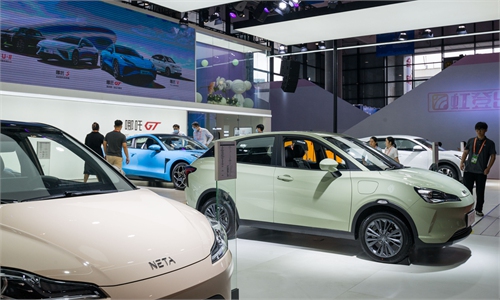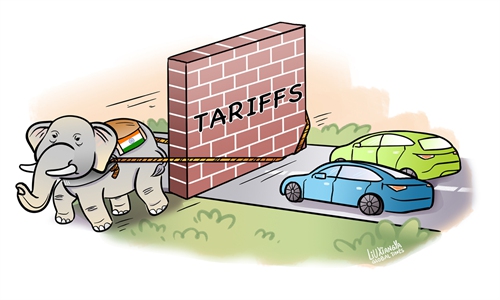
Illustration: Xia Qing/Global Times
As China leads in the electric vehicle (EV) field, it has made major steps toward forming its own technological development system, an example of the manufacturing sector's evolution and upgrading. It's also the key to how Chinese manufacturing will manage to break US containment.The Ministry of Industry and Information Technology said on Monday that it had issued guidance on formulating national automotive chip standards, the Xinhua News Agency reported. By 2025, the country will develop more than 30 key standards for automotive chips.
By 2030, more than 70 standards will be formulated to support the development of forward-looking, integrated automotive chip technology and products.
The move means that the rapid development of China's EV industry can bring Chinese standards and production systems to the world. It also represents an important development direction for Chinese manufacturing, which is to gradually establish its own production and technology systems, rather than following in the footsteps of the West.
More importantly, it means that foreign companies will also become part of the Chinese EV technology system if they want to tap into the Chinese market.
This development can't be stopped by the political climate in Washington. For instance, Nvidia said on Monday at the CES technology conference in Las Vegas, Nevada that four Chinese EV brands will use its technology as the brains for autonomous driving systems, Reuters reported.
The US chipmaking giant's plan to expand in China comes at a time when US lawmakers are still calling for new efforts to counter China's chip industry, according to a report from The Wall Street Journal.
Given the global competitiveness of China's EV industry, Nvidia's decision to participate in a promising sector is totally understandable. In the first 11 months of 2023, Chinese firms produced 8.43 million EVs, up 34.5 percent year-on-year, while sales increased by 36.7 percent to 8.3 million units, according to the China Association of Automobile Manufacturers.
Most importantly, China has an irreplaceable capacity for manufactured goods, and it's already a leader in combining artificial intelligence (AI) with commercial applications. High-end chips rely on the development of these finished products.
In addition to EVs, Chinese companies have placed growing importance on independent research and development to form their own systems in some high-tech fields.
For instance, the C919 aircraft ushered in an era of cooperation between foreign manufacturers and the Chinese aircraft manufacturing system. That system is conducive to China's development of an advanced and comprehensive aviation industry.
Moreover, Huawei is reported to have developed its HarmonyOS operating system into an independent ecosystem, similar to Apple's iOS and Google's Android.
Also, Chinese internet giants like Alibaba, Tencent and Baidu are developing their own AI systems.
This may be something beyond what the US could anticipate or forecast. Some in Washington think they could cut China off from key supplies and make it very hard for China to move up the industry chain. They believe that even with a possible breakthrough in chips, it will still take a long time for China to catch up.
Yet, as Chinese companies no longer follow their old methods but instead pursue their own standards and systems when it comes to industrial upgrading and transformation, the whole picture changes.
It means that foreign suppliers and manufacturers need to sell parts in accordance with Chinese companies' designs, standards and systems. They have to participate in the Chinese production system to keep up with Chinese standards.
Cooperation with foreign companies is needed for Chinese manufacturing to achieve industrial and technological upgrading, while foreign companies also need to upgrade by supporting China's industrial system.
Only by integrating into the Chinese manufacturing system can they become more competitive and maximize their interests.
Such a trend may be key to finding new ways for Chinese manufacturing to break Washington's technological stranglehold.



